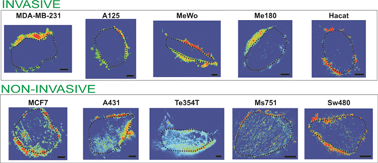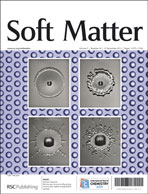Invasive cancer cell lines exhibit biomechanical properties that are distinct from their noninvasive counterparts†
Abstract
Identifying the properties that distinguish invasive cells from noninvasive cells is of prime interest in understanding metastasis formation during cancer. We have taken pairs of cells from five organ types, each consisting of a highly invasive cell line and its noninvasive counterpart, and characterized their active and passive biomechanical properties in assays that mimic the mechanical perturbations likely experienced by in vivo metastasizing tumor cells. Our setup applies compressive pressure to the entire cellvia a flat SFM cantilever while directly measuring the cell's deformation during loading, as well as its relaxation and plasticity during unloading. Simultaneously, the basal membrane is imaged viaTIRF, yielding insights into the mechanism of force transduction during loading and force generation during relaxation. Four of the five noninvasive cell lines tested appear stiffer under whole cell compression than the corresponding invasive cell line. After the force is lifted and cells are allowed to relax, all invasive cell lines exhibit greater recovery behavior as evidenced by higher retraction and lower plasticity. This retraction is observed to be an active process that is mostly dependent on the acto-myosin contractile apparatus and on actin remodeling. Combined with observed consistent distinctions in force transduction of invasive cells, the results hint at a direct connection between invasiveness and active and passive biomechanical properties of cancer cells, and as such may be relevant for understanding how some tumor cells adapt to the mechanical requirements of metastasis formation.


 Please wait while we load your content...
Please wait while we load your content...